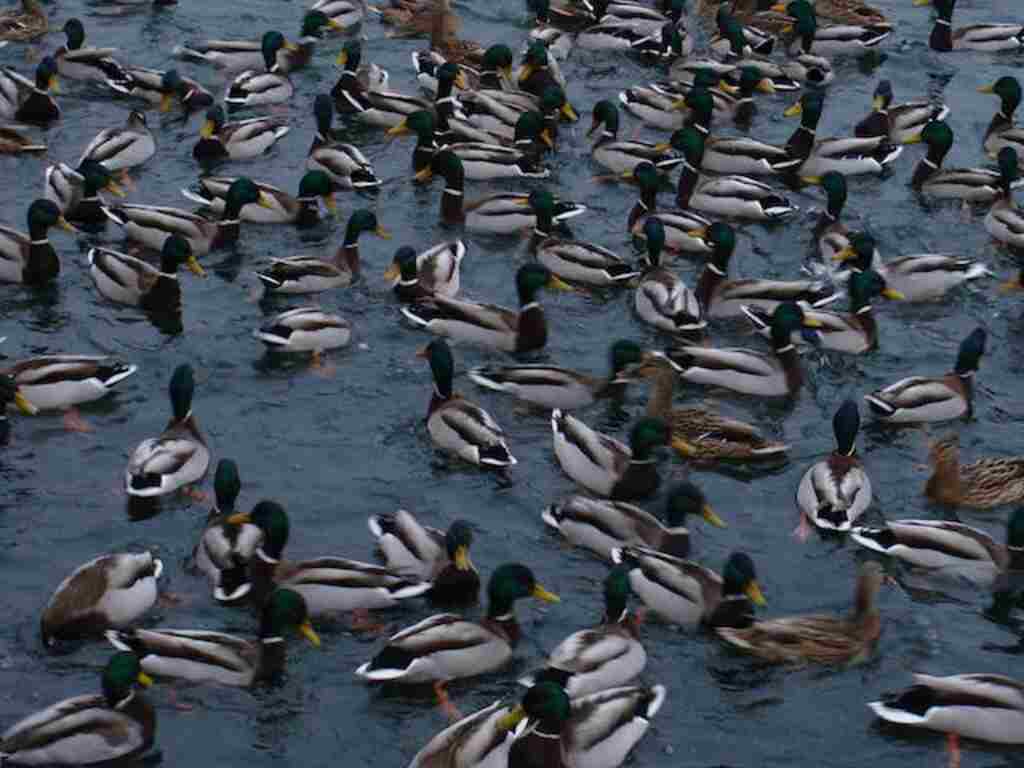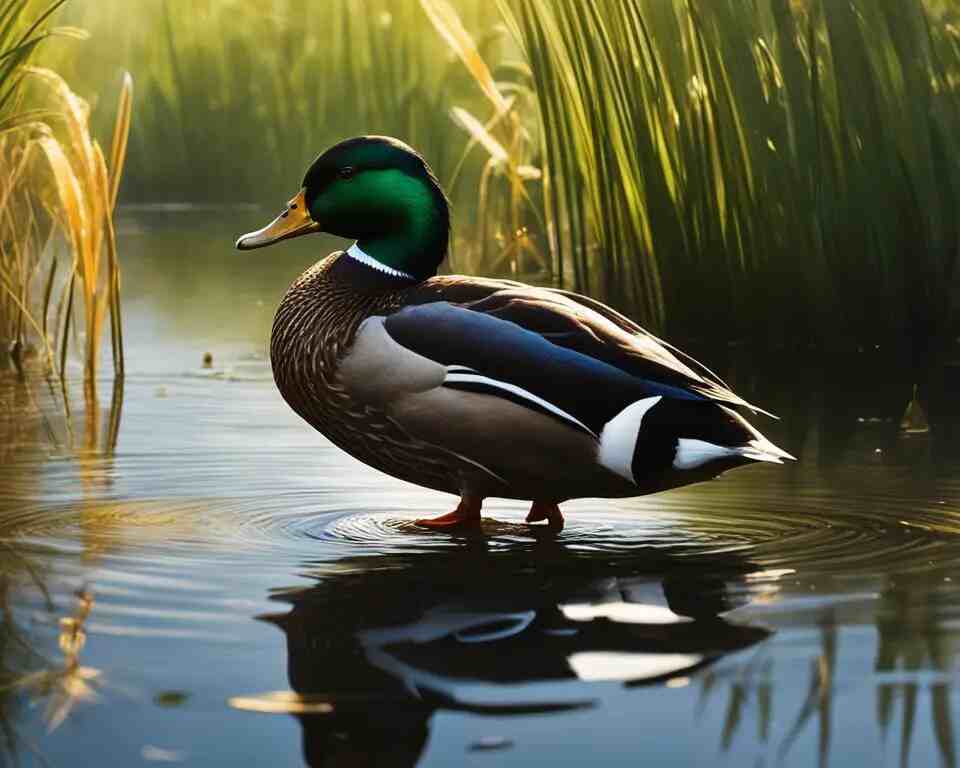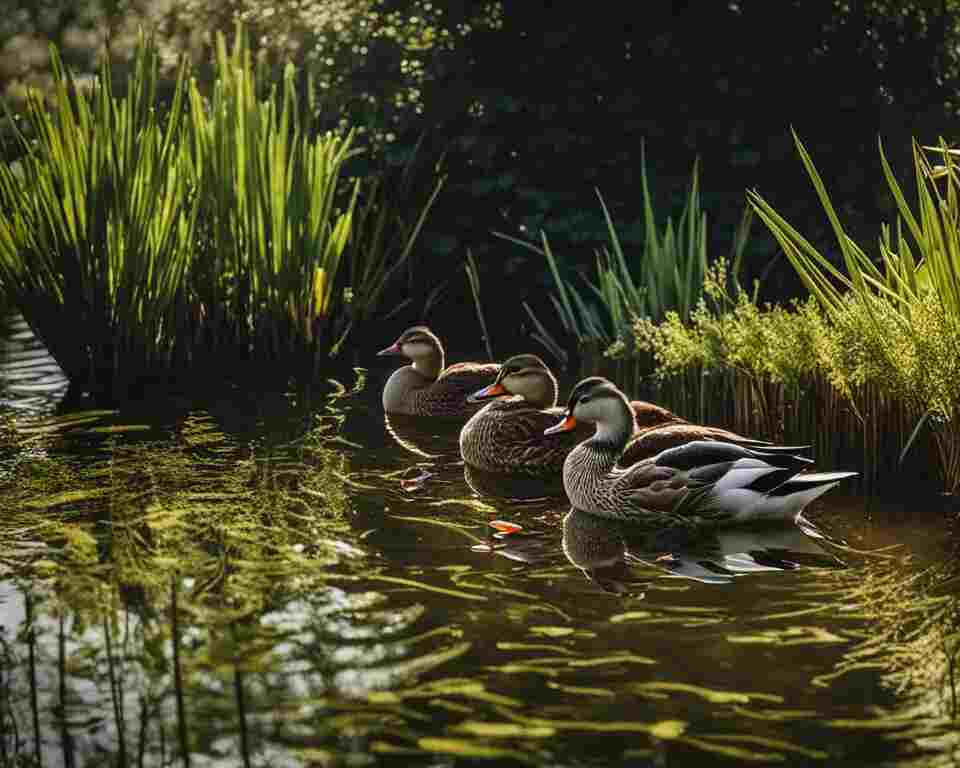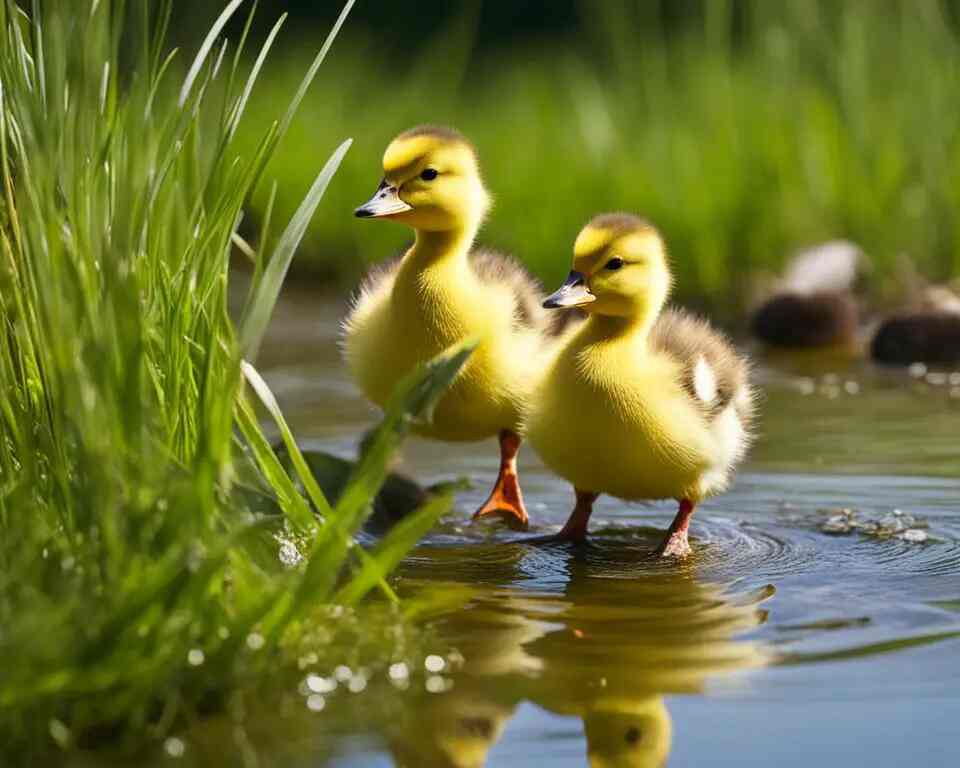Ever watched a duck dabbling in a pond and wondered what it’s snacking on? What do ducks eat in the wild? These adaptable birds forage for a surprisingly varied menu, including aquatic plants, insects, small fish, and even algae. Whether they’re skimming the surface or diving deep, wild ducks know exactly where to find their next meal. In this guide, we’ll explore what fuels these aquatic birds in their natural habitats.
Table of Contents
- 1 Key Takeaways:
- 2 The Diet of Dabbling Ducks
- 3 The Diet of Diving Ducks
- 4 Insects and Invertebrates in a Duck’s Diet
- 5 Ducks and Their Plant-based Food Sources
- 6 Ducks and Their Preference for Fish and Aquatic Creatures
- 7 Urban Duck Diets and Responsible Feeding
- 8 Duckling Diet and Development
- 9 Seasonal Variations in Duck Diets
- 10 Conclusion
- 11 FAQ
- 11.1 What do ducks eat in the wild?
- 11.2 What are the types of food that ducks forage in the wild?
- 11.3 What do dabbling ducks eat?
- 11.4 What is the diet of diving ducks?
- 11.5 What insects and invertebrates do ducks eat?
- 11.6 What are the plant-based food sources for ducks?
- 11.7 Do ducks eat fish and aquatic creatures?
- 11.8 What should I feed ducks in urban areas?
- 11.9 What do ducklings eat?
- 11.10 How do ducks modify their diet seasonally?
- 12 Source Links
- 13 Author
Key Takeaways:
- Ducks are omnivorous birds, meaning they consume both plants and animals in their diet.
- The specific food ducks eat depends on their habitat and the availability of food sources.
- Different species of ducks may have specific dietary preferences, but all require a balanced diet for their health.
- Ducks modify their diet throughout the year, with seasonal variations in the types of food they consume.
- They have different feeding behaviors, either dabbling or diving, for their food.
The Diet of Dabbling Ducks
Dabbling ducks, a category of ducks that inhabit shallow waters, have specific dietary preferences that align with their natural habitat. These ducks feed by dipping their heads underwater to scoop up vegetation and insects, while also grazing on land for seeds and grain.
Their diet primarily consists of aquatic plants such as grasses, sedges, pondweed, and rushes. However, dabbling ducks also consume other plant-based foods, including the leafy parts of aquatic vegetation, seeds of wetland plants, berries, buds, flowers, and even acorns.
These ducks showcase a diverse range of food preferences, allowing them to adapt to changing food availability and maintain a balanced diet. By foraging for a variety of plant-based foods both in and out of the water, dabbling ducks ensure they have access to the necessary nutrients to sustain their health in their natural habitat.
To visualize the diet of dabbling ducks, here is a comprehensive table detailing their food preferences:
| Plant-Based Foods | Other |
|---|---|
| Aquatic plants (grasses, sedges, pondweed, rushes) | Berries |
| Leafy parts of aquatic vegetation | Buds |
| Seeds of wetland plants | Flowers |
| Acorns | – |
With their unique dietary habits, dabbling ducks contribute to the biodiversity of their natural habitats by playing a vital role in seed dispersal and plant growth, while also serving as pollinators for certain plant species.
The Diet of Diving Ducks
Diving ducks are a category of ducks that have specialized feeding behaviors and consume a variety of food sources in their natural habitat. These ducks have adaptations that allow them to dive deep below the water’s surface in search of their prey. Their diet primarily consists of fish, aquatic invertebrates, and aquatic plants.
When it comes to fish, diving ducks mainly feed on small species like minnows and sticklebacks. They use their sharp, serrated bills to capture and eat these fish. Additionally, they also consume aquatic invertebrates such as clams, snails, and crustaceans, which they find by diving and foraging in the water. Some diving ducks even eat the roots and tubers of aquatic plants.
One interesting species of diving duck is the merganser. They have developed a specialized bill that allows them to catch and eat fish. These ducks are known for their exceptional diving and swimming abilities, which they use to pursue and capture their prey underwater. The merganser’s diet consists primarily of small fish, making them true specialists in piscivorous feeding.
Table: Comparison of Diving Duck Diets
| Duck Species | Main Food Sources |
|---|---|
| Mallard | Fish eggs, aquatic invertebrates, aquatic plants |
| Merganser | Fish, aquatic invertebrates, aquatic plants |
| Canvasback | Aquatic plants, seeds, tubers |
| Scaup | Fish, mollusks, aquatic invertebrates, aquatic plants |
As you can see from the table above, different species of diving ducks have slightly different dietary preferences. While fish and aquatic invertebrates are common food sources for diving ducks, the extent to which they rely on these sources may vary.
Some diving ducks, like the canvasback, primarily feed on aquatic plants, seeds, and tubers, while others, like the scaup, have a more diversified diet that includes fish, mollusks, aquatic invertebrates, and aquatic plants.
Insects and Invertebrates in a Duck’s Diet
Ducks have a diverse diet that includes both plants and animals. In addition to consuming vegetation and plant-based foods, ducks also rely on insects and invertebrates as part of their diet. These small creatures provide essential nutrients and proteins for the ducks’ growth and overall health.
Both dabbling ducks and diving ducks consume a variety of insects and invertebrates, although their feeding preferences may vary. Dabbling ducks tend to eat more terrestrial species, while diving ducks specialize in feeding on aquatic species.
They feed on a wide range of insects such as midges, horseflies, beetles, and aquatic insects. Additionally, they consume invertebrates like clams, snails, crustaceans, and even mussels and crabs in certain cases.
“Ducks feed on midges, horseflies, beetles, clams, snails, crustaceans, and aquatic insects.”
An interesting practice known as rice-duck farming has been introduced in Asia, where ducks are raised in paddy fields. Ducks play a crucial role in this farming system as they help control harmful insects and weeds without the need for pesticides. This symbiotic relationship showcases the natural feeding behavior of ducks and their ability to consume insects as part of their diet.
Table: Examples of Insects and Invertebrates Consumed by Ducks
| Insects | Invertebrates |
|---|---|
| Midges | Clams |
| Horseflies | Snails |
| Beetles | Crustaceans |
| Aquatic insects | Mussels |
The inclusion of insects and invertebrates in a duck’s diet highlights their adaptability to thrive in various ecosystems. It also emphasizes the importance of maintaining diverse habitats that support a wide range of food sources for these fascinating waterfowl.
Ducks and Their Plant-based Food Sources
When it comes to their diet, ducks are known to have diverse preferences, including a range of plant-based food sources. They forage for various types of vegetation in their natural habitats, including grasses, sedges, pondweed, rushes, and wetland plant seeds.
These plant materials provide essential nutrients for their growth and overall well-being. In addition to aquatic vegetation, ducks also consume other plant-based food sources such as berries, buds, seeds, and flowers, which contribute to their balanced diet.
Wood ducks, in particular, are known to have a fondness for acorns. These small, nutritious nuts are high in fats and carbohydrates, providing ducks with a valuable energy source. By including a variety of plants in their diet, ducks can meet their nutritional requirements and maintain optimal health.
It is important to note that the specific dietary preferences of ducks may vary depending on the species and their particular habitat. Different ducks may have different foraging patterns and behaviors when it comes to searching for plant-based food sources. However, it is generally observed that ducks adapt their diet to the available food sources in their environment, ensuring their survival and well-being.
Ducks and Their Preference for Fish and Aquatic Creatures
When it comes to the diets of wild ducks, fish and aquatic creatures play a role, although they do not make up a significant portion of their food intake. Diving ducks, such as scoters and goldeneyes, have a particular taste for fish.
However, most ducks consume fish eggs or roe, which they find in their natural habitats. Interestingly, in a study where mallards were fed carp eggs, the eggs were found to successfully hatch. The survival of fish eggs in this way in the wild, however, has not yet been fully determined.
In addition to fish, some ducks also include other aquatic creatures in their diet. They feed on frogspawn, tadpoles, and even small snakes. Muscovy ducks, known for their adaptability, are particularly skilled at devouring snakes.
These preferences for aquatic creatures demonstrate the diversity in wild duck feeding patterns and their ability to adapt to different food sources in their natural habitats.
“While fish and aquatic creatures do not make up a significant portion of a duck’s diet, some species, such as diving ducks, include them in their food preferences.”
The varying food preferences of ducks underscore the importance of understanding the types of food available to them in the wild. By studying their feeding patterns, researchers gain insights into the delicate balance of nature and how ducks fit into the greater ecosystem.
It’s fascinating to observe how these birds navigate their environment and make use of the resources available to them.
Table: Types of Food for Wild Ducks
| Food Type | Description |
|---|---|
| Aquatic Plants | Including grasses, sedges, pondweed, rushes, and wetland plant seeds. |
| Insects and Invertebrates | Feasting on midges, horseflies, beetles, clams, snails, crustaceans, and aquatic insects. |
| Fish and Fish Eggs | For diving ducks, fish eggs or roe are an occasional treat. |
| Frogs, Tadpoles, and Small Snakes | Some ducks add these aquatic creatures to their diet. |
| Acorns and Berries | Wood ducks have a fondness for acorns, while other ducks enjoy berries. |
| Human Handouts | In urban areas, ducks may rely on food provided by humans. |
Urban Duck Diets and Responsible Feeding
Feeding ducks in their natural habitat can be a delightful experience, but it’s important to approach it responsibly. Ducks in urban and suburban areas often rely on human handouts for food, but not all foods are suitable for their nutritional needs.
Feeding ducks unhealthy foods like bread can lead to malnutrition and health issues, impacting their overall well-being. It’s essential to provide them with nutritious options that mimic their natural diet in a responsible manner.
When feeding ducks in urban areas, consider offering them nutritious alternatives such as lettuce, peas, sweetcorn, oats, and seeds. These options provide the necessary nutrients while also satisfying their natural feeding habits.
It’s important to avoid offering large quantities of food, as overfeeding can lead to overcrowding and the spread of diseases among duck populations.
Remember, responsible feeding practices contribute to the overall health of ducks. By providing them with a balanced diet that reflects their natural feeding habits, you can help ensure their well-being in urban environments.
So the next time you encounter ducks in your local park or waterway, choose to feed them responsibly and make a positive impact on their lives.
| Healthy Foods for Feeding Ducks | Unhealthy Foods to Avoid |
|---|---|
|
|
Duckling Diet and Development
When it comes to the diet and development of ducklings, there are some key factors to consider. Ducklings have specific dietary needs that differ from adult ducks. In the wild, ducklings primarily rely on insects and small invertebrates as their main food source during their first month of life.
These protein-rich foods help support their rapid growth and development. As they grow older, they start incorporating more plant material and seeds into their diet, gradually transitioning to a primarily vegetarian diet by the age of 6 weeks.
For domestic ducklings, it is essential to provide them with specially formulated starter crumble and grower foods to ensure their healthy development.
These foods are designed to meet the nutritional needs of growing ducklings, providing them with the necessary vitamins, minerals, and proteins they require.
It is important to carefully follow feeding guidelines and monitor their growth to ensure they are receiving the proper nutrition and developing correctly.
As ducklings transition from the early stages of their diet, it is crucial to introduce them to a variety of food sources to support their nutritional needs. This includes offering a mix of insects, invertebrates, aquatic vegetation, and high-quality commercial duck feeds.
By providing a diverse diet, ducklings can develop a broad palate and acquire the necessary nutrients for their overall health and growth.
Seasonal Variations in Duck Diets
Wild ducks exhibit seasonal variations in their diets as they adapt to the changing availability of food sources. These variations ensure their survival in different seasons and reflect their natural instinct to find the most abundant and suitable food for their nutritional needs.
During the spring and summer months, ducks have access to a wide range of food options in their natural habitats. They take advantage of the abundance of insects, frogs, and fish eggs, as well as a variety of aquatic vegetation.
These food sources provide the necessary nutrients for ducks during the breeding season and support their energy requirements for migration.
As the weather turns colder in the fall and winter, many duck species shift their diets to primarily vegetarian options. They rely on seeds, grain, acorns, and tubers to sustain them through the leaner months.
By modifying their diet to include plant-based foods, wild ducks can still find sufficient nutrition in their environment, even when their preferred animal-based food sources become scarce.
Duck Diet Composition
The composition of a wild duck’s diet depends on factors such as the species, habitat, and seasonal availability of food sources. While specific percentages may vary, a typical duck diet consists of approximately 70-80% plant matter and 20-30% animal matter. This composition allows ducks to meet their nutritional requirements and maintain their overall health and well-being.
Below is a table summarizing the main components of a wild duck’s diet:
| Food Source | Percentage of Diet |
|---|---|
| Aquatic Vegetation | 40-50% |
| Seeds, Grain, and Acorns | 20-30% |
| Insects and Invertebrates | 10-20% |
| Fish and Fish Eggs | 5-10% |
| Other Animal Matter | 5-10% |
It is important to note that these percentages are approximate and can vary depending on the specific species and environmental conditions. Ducks have evolved to be adaptable and flexible in their diet, allowing them to thrive in a variety of habitats and seasons.
“Ducks modify their diet seasonally to adapt to the changing availability of food sources.” – Wildlife Biologist
Conclusion
Ducks have a diverse diet that includes both plants and animals. They forage for a variety of food sources in their natural habitats, feeding on aquatic and terrestrial plants, insects, fish, and other aquatic creatures. Ducks have different feeding behaviors based on their species and habitat preferences.
It is essential to provide them with a balanced and nutritious diet, taking into consideration their waterfowl diet and nutritional needs. Whether in their natural habitats or in urban areas where they may rely on human feeding, responsible feeding practices ensure the health and well-being of ducks.
Understanding what ducks eat and providing them with appropriate food sources is crucial for their survival. Whether it’s aquatic vegetation, insects, or fish, each component contributes to their overall nutrition. By respecting their dietary needs and maintaining a suitable environment, we can help ensure the well-being of these beautiful waterfowl species.
FAQ
What do ducks eat in the wild?
Ducks are omnivorous birds and their diet consists of a variety of plants and animals. The specific food they consume depends on the habitat they live in and the availability of food.
What are the types of food that ducks forage in the wild?
Ducks forage for a range of food sources, including aquatic and terrestrial plants, insects, fish, and other aquatic creatures.
What do dabbling ducks eat?
Dabbling ducks primarily feed on aquatic plants such as grasses, sedges, pondweed, rushes, as well as the seeds and leafy parts of wetland plants. They also consume berries, buds, seeds, flowers, and acorns.
What is the diet of diving ducks?
Diving ducks mainly consume fish, aquatic invertebrates like clams and snails, aquatic plants, and the roots and tubers of plants. Some diving ducks specialize in catching and eating fish.
What insects and invertebrates do ducks eat?
Ducks feed on a wide range of insects and invertebrates, including midges, horseflies, beetles, clams, snails, crustaceans, and aquatic insects. Some species even eat mussels and crabs.
What are the plant-based food sources for ducks?
Ducks feed on a variety of plant-based foods, including aquatic vegetation such as grasses, sedges, pondweed, rushes, as well as berries, buds, seeds, and flowers. Wood ducks are known to eat acorns.
Do ducks eat fish and aquatic creatures?
While fish and aquatic creatures do not make up a significant portion of a duck’s diet, some species, like diving ducks, include them in their food preferences. They consume fish eggs or roe, and certain ducks like muscovy ducks are known to eat snakes.
What should I feed ducks in urban areas?
When feeding ducks in urban areas, it is important to provide them with nutritious options like lettuce, peas, sweetcorn, oats, and seeds. Feeding unhealthy foods like bread can lead to malnutrition and health issues.
What do ducklings eat?
In the wild, ducklings primarily feed on insects and small invertebrates during their first month. As they grow, they incorporate more plant material and seeds into their diet. Domestic ducklings require specific starter crumble and grower foods for their healthy development and growth.
How do ducks modify their diet seasonally?
Ducks adjust their diet throughout the year based on the changing availability of food sources. In spring and summer, they have abundant options, including insects, frogs, fish eggs, and aquatic vegetation. As the weather turns colder in fall and winter, many ducks become mainly vegetarian, relying on seeds, grain, acorns, and tubers.





